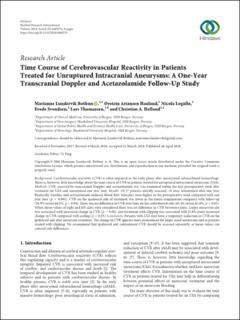| dc.contributor.author | Bøthun, Marianne Lundervik | en_US |
| dc.contributor.author | Haaland, Øystein Ariansen | en_US |
| dc.contributor.author | Logallo, Nicola | en_US |
| dc.contributor.author | Svendsen, Frode | en_US |
| dc.contributor.author | Thomassen, Lars | en_US |
| dc.contributor.author | Helland, Christian Andre | en_US |
| dc.date.accessioned | 2019-05-08T12:14:30Z | |
| dc.date.available | 2019-05-08T12:14:30Z | |
| dc.date.issued | 2018-04-26 | |
| dc.Published | Bøthun M, Haaland ØA, Logallo N, Svendsen F, Thomassen L, Helland CA. Time course of cerebrovascular reactivity in patients treated for unruptured intracranial aneurysms: A one-year transcranial Doppler and acetazolamide follow-up study. BioMed Research International. 2018;2018:6489276 | eng |
| dc.identifier.issn | 2314-6133 | |
| dc.identifier.issn | 2314-6141 | |
| dc.identifier.uri | https://hdl.handle.net/1956/19591 | |
| dc.description.abstract | Background. Cerebrovascular reactivity (CVR) is ofen impaired in the early phase afer aneurysmal subarachnoid hemorrhage. Tere is, however, little knowledge about the time course of CVR in patients treated for unruptured intracranial aneurysms (UIA). Methods. CVR, assessed by transcranial Doppler and acetazolamide test, was examined within the frst postoperative week afer treatment for UIA and reexamined one year later. Results. Of 37 patients initially assessed, 34 were reexamined afer one year. Bilaterally, baseline and acetazolamide-induced blood fow velocities were higher in the postoperative week compared with one year later (p < 0.001). CVR on the ipsilateral side of treatment was lower in the initial examination compared with follow-up (58.9% versus 66.1%, p = 0.04). Tere was no diference in CVR over time on the contralateral side (63.4% versus 65.0%, p = 0.65). When mean values of right and lef sides were considered there was no diference in CVR between exams. Larger aneurysm size was associated with increased change in CVR (p = 0.04), and treatment with clipping was associated with 13.8%-point increased change in CVR compared with coiling (p = 0.03). Conclusion. Patients with UIA may have a temporary reduction in CVR on the ipsilateral side afer aneurysm treatment. Te change in CVR appears more pronounced for larger-sized aneurysms and in patients treated with clipping. We recommend that ipsilateral and contralateral CVR should be assessed separately, as mean values can conceal side-diferences. | en_US |
| dc.language.iso | eng | eng |
| dc.publisher | Hindawi | eng |
| dc.rights | Attribution CC BY | eng |
| dc.rights.uri | http://creativecommons.org/licenses/by/4.0 | eng |
| dc.title | Time course of cerebrovascular reactivity in patients treated for unruptured intracranial aneurysms: A one-year transcranial Doppler and acetazolamide follow-up study | en_US |
| dc.type | Peer reviewed | |
| dc.type | Journal article | |
| dc.date.updated | 2019-02-12T17:21:49Z | |
| dc.description.version | publishedVersion | en_US |
| dc.rights.holder | Copyright 2018 The Author(s) | |
| dc.identifier.doi | https://doi.org/10.1155/2018/6489276 | |
| dc.identifier.cristin | 1589499 | |
| dc.source.journal | BioMed Research International | |

